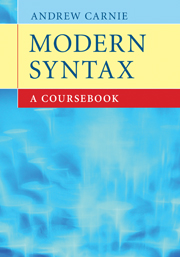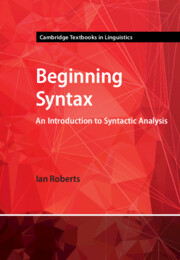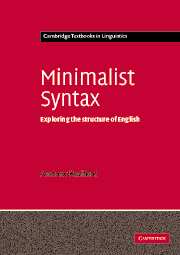Modern Syntax
This practical coursebook introduces all the basics of modern syntactic analysis in a simple step-by-step fashion. Each unit is constructed so that the reader discovers new ideas, formulates hypotheses and practises fundamentals. The reader is presented with short sections of explanation with examples, followed by practice exercises. Feedback and comment sections follow to enable students to monitor their progress. No previous background in syntax is assumed. Students move through all the key topics in the field including features, rules of combination and displacement, empty categories, and subcategorization. The theoretical perspective in this work is unique, drawing together the best ideas from three major syntactic frameworks (minimalism, HPSG and LFG). Students using this book will learn fundamentals in such a way that they can easily go on to pursue further study in any of these frameworks.
- Unique approach to introducing the topic with short explanatory sections followed by stimulating practice exercises to be completed on the page
- Feedback and comment sections allow students to monitor their understanding of the material
- Assumes no previous background in syntax
Reviews & endorsements
'An ideal point of entry into the complex and challenging science of natural language syntax. Highly recommended.' Cedric Boeckx, ICREA and Universitat Autònoma de Barcelona
'This is a daring introduction into syntax. Rather than telling students what syntactic theory looks like, it makes them do syntax. Rather than presenting them with a standard framework, it provides students with the tools and knowledge to pursue any of the major theories. This is a friendly and experienced guide to the rough terrain and breathtaking vistas of modern syntactic theory.' Ad Neeleman, Professor of Linguistics, University College London
Product details
January 2011Paperback
9780521682046
370 pages
247 × 174 × 18 mm
0.74kg
Available
Table of Contents
- Part I. Basic Ideas in Syntax:
- 1. Defining syntax
- 2. Syntactic data
- 3. Hypotheses: rules
- Part II. Categories and Subcategories:
- 4. Words and lexical categories
- 5. Functional categories
- 6. Pronouns
- 7. Other subcategories of nouns
- 8. Subcategories of verbs
- 9. Tangent: tense, aspect and mood
- 10. Auxiliaries
- Part III. Constituents, Merge and Trees:
- 11. Constituency
- 12. Complements
- 13. Complements: a case study
- 14. Specifiers of VP and TP
- 15. Specifiers of NP and DP
- 16. Tagging
- 17. Adjuncts
- 18. Drawing trees
- Part IV. Movement and Control:
- 19. Passives
- 20. Non-finite clauses 1: control constructions
- 21. Non-finite clauses 1: raising constructions
- 22. Head movement 1: auxiliaries
- 23. Head movement 2: main verbs
- 24. Wh-movement
- Part V. Conclusions and Appendices:
- 25. Evaluating our progress
- 26. The next steps
- Appendix 1. Glossary, symbols and abbreviations
- Appendix 2. Features and their values
- Appendix 3. Rules, constraints and principles.






